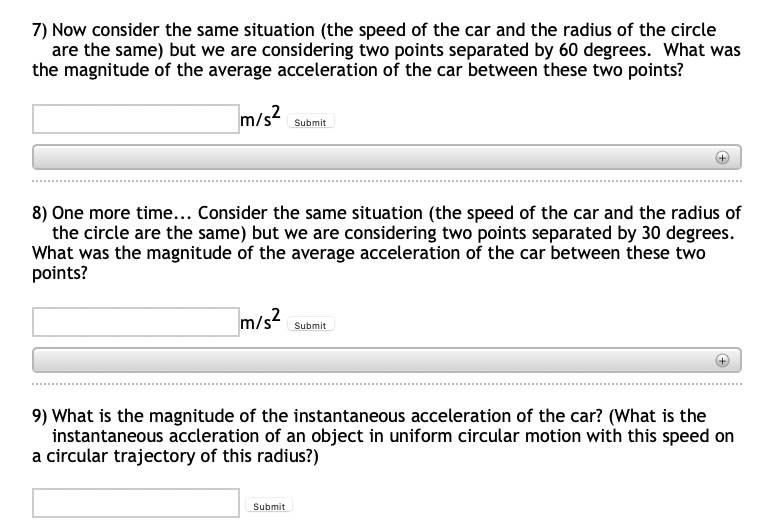7) Now consider the same situation (the speed of the car and the radius of the circle are the same) but we are considering two points separated by 60 degrees. What was the magnitude of the average acceleration of the car between these two points? m/s2 Submit
7) Now consider the same situation (the speed of the car and the radius of the circle are the same) but we are considering two points separated by 60 degrees. What was the magnitude of the average acceleration of the car between these two points? m/s2 Submit
University Physics Volume 1
18th Edition
ISBN:9781938168277
Author:William Moebs, Samuel J. Ling, Jeff Sanny
Publisher:William Moebs, Samuel J. Ling, Jeff Sanny
Chapter2: Vectors
Section: Chapter Questions
Problem 71AP: You fly 32.0 km in a straight line in still air in the direction 35.0 south of west. (a) Find the...
Related questions
Question
Please do question 7,8, and 9 the others are all correct.
![A car was driving around a horizontal circular track at a constant speed of 16 m/s. The
diagram above shows the view from above. The track has a radius of 60 meters.
1) At one time the car was driving to the left, shown by the velocity vector v1 above.
After driving halfway around the track, the car was moving to the right, shown by
the vector v2 above. What was the magnitude of the change in velocity between these
two times?
32
m/s Submit
2) What was the time interval between the two points indicated in the diagram above
(when the car was at opposite sides of the circular track)? [Note: the car moved
only one half of a circumference in that time.]
11.8
Submit
3) What was the magnitude of the average acceleration of the car between the two
times shown in the diagram above?
2.71
m/s submit
4) Velocities at two other times...
The diagram above shows the velocity vectors for the car at two other times,
separated by an angle theta. (In the original diagram, theta was equal to pi or 180
degrees. In this diagram, theta is less than that.)
The speed of the car (16 m/s) and the radius of the circle (60 m) are the same as
above.
What is the magnitude of the change in velocity if theta = 120 degrees?
27.72
m/s Submit
+
5) What was the time interval between the times when the car was at the two points
separated by 120 degrees?
7.9
Submit
+
6) What was the avearage acceleration of the car between the two points that are
separated by 120 degrees?
3.5
m/s2
Submit](/v2/_next/image?url=https%3A%2F%2Fcontent.bartleby.com%2Fqna-images%2Fquestion%2F851901a2-7275-4527-968f-3a9a98cde9f0%2F7ce6bed9-3b59-45be-9112-7557e80c091f%2F0ohb22i_processed.png&w=3840&q=75)
Transcribed Image Text:A car was driving around a horizontal circular track at a constant speed of 16 m/s. The
diagram above shows the view from above. The track has a radius of 60 meters.
1) At one time the car was driving to the left, shown by the velocity vector v1 above.
After driving halfway around the track, the car was moving to the right, shown by
the vector v2 above. What was the magnitude of the change in velocity between these
two times?
32
m/s Submit
2) What was the time interval between the two points indicated in the diagram above
(when the car was at opposite sides of the circular track)? [Note: the car moved
only one half of a circumference in that time.]
11.8
Submit
3) What was the magnitude of the average acceleration of the car between the two
times shown in the diagram above?
2.71
m/s submit
4) Velocities at two other times...
The diagram above shows the velocity vectors for the car at two other times,
separated by an angle theta. (In the original diagram, theta was equal to pi or 180
degrees. In this diagram, theta is less than that.)
The speed of the car (16 m/s) and the radius of the circle (60 m) are the same as
above.
What is the magnitude of the change in velocity if theta = 120 degrees?
27.72
m/s Submit
+
5) What was the time interval between the times when the car was at the two points
separated by 120 degrees?
7.9
Submit
+
6) What was the avearage acceleration of the car between the two points that are
separated by 120 degrees?
3.5
m/s2
Submit

Transcribed Image Text:7) Now consider the same situation (the speed of the car and the radius of the circle
are the same) but we are considering two points separated by 60 degrees. What was
the magnitude of the average acceleration of the car between these two points?
m/s?
Submit
8) One more time... Consider the same situation (the speed of the car and the radius of
the circle are the same) but we are considering two points separated by 30 degrees.
What was the magnitude of the average acceleration of the car between these two
points?
Submit
9) What is the magnitude of the instantaneous acceleration of the car? (What is the
instantaneous accleration of an object in uniform circular motion with this speed on
a circular trajectory of this radius?)
Submit
Expert Solution
This question has been solved!
Explore an expertly crafted, step-by-step solution for a thorough understanding of key concepts.
This is a popular solution!
Trending now
This is a popular solution!
Step by step
Solved in 2 steps

Knowledge Booster
Learn more about
Need a deep-dive on the concept behind this application? Look no further. Learn more about this topic, physics and related others by exploring similar questions and additional content below.Recommended textbooks for you

University Physics Volume 1
Physics
ISBN:
9781938168277
Author:
William Moebs, Samuel J. Ling, Jeff Sanny
Publisher:
OpenStax - Rice University

University Physics Volume 1
Physics
ISBN:
9781938168277
Author:
William Moebs, Samuel J. Ling, Jeff Sanny
Publisher:
OpenStax - Rice University